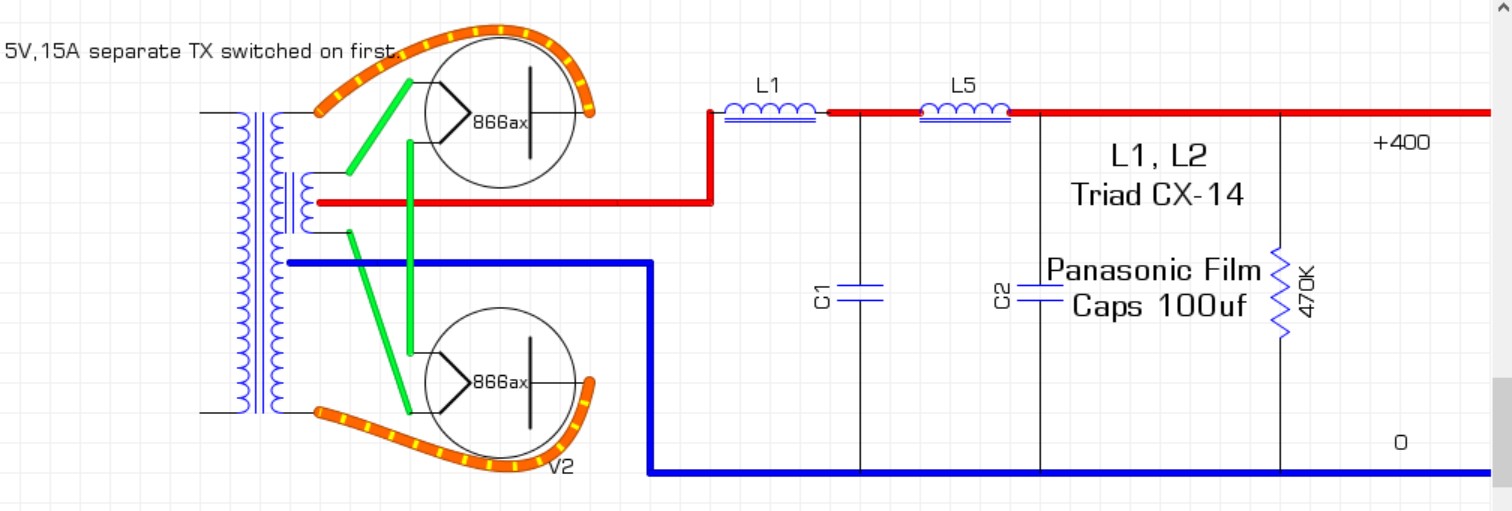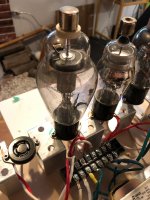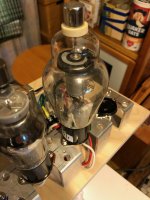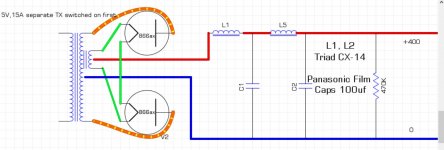I’m investigating a strange issue with a proven design: I’ve multiple 866A diodes that in their bridge rectification duties begin to flicker. It’s not on and off flicker, it’s as if the gas is glowing on one side of the tube then the other maybe 4 times a second.
There is no fluctuations in voltage and the music sounds fine but I feel I must not continue listening if I’ve got a tube flickering.
I’ve rotated positions so I know it’s not the hardware, it’s maybe pressure within the tube? I don’t know. I’m asking for information 😀
I’ve got a dozen 866A so I’m rotating through them to find a fourth (I have three that are rock steady if low glow...) that is steady at this point. I’ve been breaking in the candidates with a four hour burn on the heaters on a board out in the garage. All the tubes were sold as NOS. I’m still wondering what’s going on...
Please assist if you’ve got a good guess.
There is no fluctuations in voltage and the music sounds fine but I feel I must not continue listening if I’ve got a tube flickering.
I’ve rotated positions so I know it’s not the hardware, it’s maybe pressure within the tube? I don’t know. I’m asking for information 😀
I’ve got a dozen 866A so I’m rotating through them to find a fourth (I have three that are rock steady if low glow...) that is steady at this point. I’ve been breaking in the candidates with a four hour burn on the heaters on a board out in the garage. All the tubes were sold as NOS. I’m still wondering what’s going on...
Please assist if you’ve got a good guess.
I have been around 866A rectifiers for 50 year plus...both from use in audio and in transmitters. How much current is being drawn by the amplifier? What voltages are you dealing with?
I have not encountered arc back when dealing with relatively low voltage such as a 1000 volt center tapped power transformer for PP 7027A tubes running around 450 volts on the plate with choke input filter and a preheat of 30 seconds before HT is applied. It is absolutely imperative to preheat the 866A or any of those M-V rectifiers to avoid arc back or damage to the heat shielded cathode. Insure the filament voltage is correct (2.5 v at 5 amp per tube). I have encountered arc back with M-V rectifiers in transmitters where the plate voltage is 2000 volts or up. As for the blue glow, it intensifies as current is drawn. With the AB1 type audio power amplifiers, you should see the glow more intense with plate current draw. The nice thing about the M-V rectifier is the voltage drop is constant (around 15 volts) regardless of the current draw which helps HT regulation.
Be careful with the M-V tubes, don't break one and release mercury vapor...have some powdered sulfur around for clean up and dispose of promptly...
FYI the 866A was used in many tubed broadcast transmitters for low voltage; the 872A, 575A, 857B, and other M-V rectifiers were used for HT rectification in higher power tubed transmitting gear.
I have not encountered arc back when dealing with relatively low voltage such as a 1000 volt center tapped power transformer for PP 7027A tubes running around 450 volts on the plate with choke input filter and a preheat of 30 seconds before HT is applied. It is absolutely imperative to preheat the 866A or any of those M-V rectifiers to avoid arc back or damage to the heat shielded cathode. Insure the filament voltage is correct (2.5 v at 5 amp per tube). I have encountered arc back with M-V rectifiers in transmitters where the plate voltage is 2000 volts or up. As for the blue glow, it intensifies as current is drawn. With the AB1 type audio power amplifiers, you should see the glow more intense with plate current draw. The nice thing about the M-V rectifier is the voltage drop is constant (around 15 volts) regardless of the current draw which helps HT regulation.
Be careful with the M-V tubes, don't break one and release mercury vapor...have some powdered sulfur around for clean up and dispose of promptly...
FYI the 866A was used in many tubed broadcast transmitters for low voltage; the 872A, 575A, 857B, and other M-V rectifiers were used for HT rectification in higher power tubed transmitting gear.
Last edited:
jdg123, how much tech measurement equipment do you have?
Assuming you have a V-0-V secondary, and full-wave rectifier configuration, then you could insert a grounded current sense resistor in the CT line and use a scope to measure the current waveform. There should be transients at each commutation, but the two half waveform periods should be about the same current level (ie. balanced) and looking at a long stream of cycles should not see any change in pulses. If there are ad hoc missing half-wave pulses then trigger on them for further inspection (eg. loss of arc or arc-back).
You should also confirm your choke current does not reach zero during normal operation.
Assuming you have a V-0-V secondary, and full-wave rectifier configuration, then you could insert a grounded current sense resistor in the CT line and use a scope to measure the current waveform. There should be transients at each commutation, but the two half waveform periods should be about the same current level (ie. balanced) and looking at a long stream of cycles should not see any change in pulses. If there are ad hoc missing half-wave pulses then trigger on them for further inspection (eg. loss of arc or arc-back).
You should also confirm your choke current does not reach zero during normal operation.
Thanks guys for the good information. I have read everything I can find about MV diodes. I have some orginal documents for their use from manufactures and have read all about those who use them and those who would never use them.
In this case I am following a proven design from an excellent designer, one he has used for multiple amps but he has never experieced this tube behavior.
I was chiefly worried it indicated the tube was bad or stressed. It seems normal for the first respondent. I have found now a fourth tube that does not stutter. All four are rock steady now in the Graetz Bridge configuration. I still don't know why the stuttering happened...
No, I do not have an analyzer, just a good multimeter.
It's a lovely amp, yes with a two stage start up to warm all heaters, ordinary voltages: 345VDC and 180mA, maybe. I will post it on the picture thread.
If anyone has further information about their experiences with MV diodes looking odd or misbehaving, let this be the tread to post on. There is VERY little out there about people working through issues with applications of MV.
Cheers All!
In this case I am following a proven design from an excellent designer, one he has used for multiple amps but he has never experieced this tube behavior.
I was chiefly worried it indicated the tube was bad or stressed. It seems normal for the first respondent. I have found now a fourth tube that does not stutter. All four are rock steady now in the Graetz Bridge configuration. I still don't know why the stuttering happened...
No, I do not have an analyzer, just a good multimeter.
It's a lovely amp, yes with a two stage start up to warm all heaters, ordinary voltages: 345VDC and 180mA, maybe. I will post it on the picture thread.
If anyone has further information about their experiences with MV diodes looking odd or misbehaving, let this be the tread to post on. There is VERY little out there about people working through issues with applications of MV.
Cheers All!
Just to add more data to the mix. My amps were monoblocks with 2 x 866A each with a 880-0-880 CT secondary. When my 866A tube started flickering, I swapped tubes. The flickering stayed with the amp, not the tube. This is not much help, but at least shows that the tubes were not the issue. I tried 8 different 866A tubes and the flickering stayed with the one monoblock. I never could solve it.
OK any data is better than none. To me this says there are tubes with issues and amps with issues as I was able to gather up a set of tubes that do not flicker. I only have one amp/psu to deal with.
I am adding one more issue (not about flickering) to the thread just because it is better to have data out there than not: I read about this delamination on RCA 866A tubes somewhere and now I have experienced it. Old tubes may not be up to snuff here in the 21st c. See photos below, note black coating shed from upper disc and laying about in the tubes innards. Ugly. This shedding came about during the process of heating the tube for an hour to get the mercury out of any place it should not be. I'll not be using this tube, it must go to dangerours recycling pile.
I am adding one more issue (not about flickering) to the thread just because it is better to have data out there than not: I read about this delamination on RCA 866A tubes somewhere and now I have experienced it. Old tubes may not be up to snuff here in the 21st c. See photos below, note black coating shed from upper disc and laying about in the tubes innards. Ugly. This shedding came about during the process of heating the tube for an hour to get the mercury out of any place it should not be. I'll not be using this tube, it must go to dangerours recycling pile.
Attachments
To expand, gas conductance in glow discharge follows Paschen's law with regard to temperature. The dependence is bathtub-shaped: conductance is highest in certain temperature region, and decreases as temperature moves outside this region in either direction. Glow in a local area heats the gas, making it less conductive than in adjacent no-glow area. As a result, glow jumps to colder area, and then process repeats.
That may have been me as I cautioned about it in this post to Brian28 on 6/26/20 "Tube rectified PSU"I read about this delamination on RCA 866A tubes somewhere and now I have experienced it.
"Depending on just what tubes you have there is a caution. The older tubes by makers like RCA, Sylvania and a couple of others have a coating on the elements that when heated can flake off. These will be the larger (full size) size 866's. The slightly smaller style, like the GE's, seems to be free of this condition. Their plates will be shiny metal compared to the dark (sometimes orange peel) coating on the older versions. When this coating comes off it will short the tube. If in doubt of what you have, power them up (2.5V) and run in series with an incandescent lamp to get them hot."
I guess the outcome could be a persistent short, and hence damage to power transformer or protection by fusing, or a short-duration high current that melts the shorting section of 'flake'.
It does highlight the need for over-current protection that suits the application, both on the primary, and also preferably on the secondary windings.
It does highlight the need for over-current protection that suits the application, both on the primary, and also preferably on the secondary windings.
Hello from Greece! See this video! 1000W Tube Amplifier Interference Pattern of the MV-Rectifiers - YouTube
Hi,
My 866s flickered too. It seemed as if the glowing gas cloud loved to change positions. I think I posted somewhere about it a long time ago, but didn't get a convincing answer. Mine were connected in a full bridge CT configuration. The interesting thing is, some tubes would stop flickering, while others would start. It was so random I couldn't find a logical pattern for years.
P.S. IIRC, making a video of the flickering couldn't register it. Was a high FPS video needed, I don't know. The flickering was some kind of glow fluctuation between the plate and the rectangular hole above the spiral cathode.
My 866s flickered too. It seemed as if the glowing gas cloud loved to change positions. I think I posted somewhere about it a long time ago, but didn't get a convincing answer. Mine were connected in a full bridge CT configuration. The interesting thing is, some tubes would stop flickering, while others would start. It was so random I couldn't find a logical pattern for years.
P.S. IIRC, making a video of the flickering couldn't register it. Was a high FPS video needed, I don't know. The flickering was some kind of glow fluctuation between the plate and the rectangular hole above the spiral cathode.
Last edited:
Very interesting video Xenophon. It is another example of good tubes behaving with a flicker. It implies that the current draw is changing causing the tubes to pass more and less current and thus change the amount of glow in both a slow, whole tube change and a flickering partial tube glow change. There is quite a variety of glowing mv vapor according to multiple conditions within the tube. Gads! So much to learn!
Well, as the video title says, the flickering shown here is an interference between the mains frequency and the power stage's load current, modulated by twice the signal frequency, hence is quite expectable. This Philips EL 6471 amplifier features a three phase main power transformer and six DCG4/1000G-01 mercury rectifiers (equivalents to 866A's) in full wave configuration that feed a pair of QB3,5/750 power tetrodes in class AB. The filter capacitor is just 2 µF.Hello from Greece! See this video! 1000W Tube Amplifier Interference Pattern of the MV-Rectifiers - YouTube
Best regards!
I recently finished breadboarding a pair of monoblocs utilizing 2 X 866ax per side. Occasionally one, not always the same one, begins flickering. When swapping tube positions results vary - sometimes follows the tube and sometimes stays with the position.
I can't hear it.
I'd like to see others' PSU schematics if anyone is willing to share.

I can't hear it.
I'd like to see others' PSU schematics if anyone is willing to share.
Attachments
I wouldn't be too concerned about flicker in a 866AX type mercury vapor ("M-V") rectifier. If a mercury vapor rectifier is not loaded or very light current flow, the tube will flicker. One matter of concern is the filament voltage with M-V tubes; the filament voltage MUST be correct at the tube socket(s) within 5 percent. Make sure no HT is applied to the to the tube(s) when making this measurement! The filament voltage is critical and undervoltage in particular can destroy the coated heat-shielded filament.
I have used M-V tubes for over 50 years in amplifiers and transmitters. Sometimes they arc-back or fail, but something downstream from the rectifier generally is the cause. M-V rectifiers were widely used where constant voltage drop, high forward current, and high PIV was required before silicon devices could work in the kilovolts and amperes range. The blue glow gets peoples' attention.
I have used M-V tubes for over 50 years in amplifiers and transmitters. Sometimes they arc-back or fail, but something downstream from the rectifier generally is the cause. M-V rectifiers were widely used where constant voltage drop, high forward current, and high PIV was required before silicon devices could work in the kilovolts and amperes range. The blue glow gets peoples' attention.
- Home
- Amplifiers
- Tubes / Valves
- Studdering mercury vapor diodes


